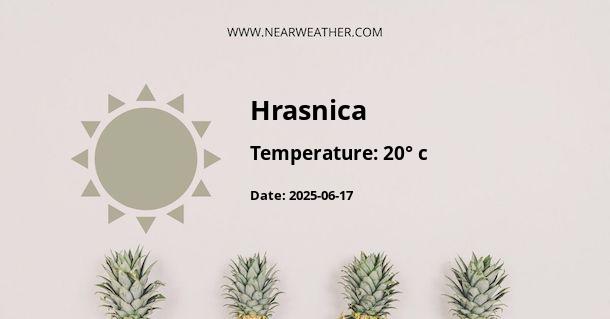Understanding the Climate and Weather of Hrasnica, Bosnia and Herzegovina
The climate of Hrasnica, a suburb of Sarajevo located in Bosnia and Herzegovina, is influenced by its geographical position in the Dinaric Alps and the continental climate system. It experiences a blend of a humid continental and oceanic climate, leading to specific weather patterns throughout the year. To provide a comprehensive overview, this analysis considers historical weather data, geographical factors, and climatic trends for Hrasnica.
Geographical Influences on Hrasnica's Climate
The weather in Hrasnica is significantly affected by its position in the mountainous regions of Bosnia and Herzegovina. The proximity of the Dinaric Alps provides a natural barrier that can lead to orographic precipitation and also influences temperature variations, often leading to cooler summers and harsher winters compared to areas outside of mountain valleys.
Seasonal Weather Patterns
The climate in Hrasnica varies seasonally, with distinct weather characteristics during different periods of the year:
Spring
Spring witnesses a gradual increase in temperatures, with average highs moving from approximately 10°C in March to around 20°C in May. Precipitation is relatively consistent, with April usually being the wettest month of the spring due to frequent rain showers.
Summer
Summertime offers warm and generally sunny weather, with average high temperatures reaching 24°C to 26°C in July and August. However, the region is not immune to sudden and heavy rainfall, often resulting from short-lived thunderstorms.
Autumn
The autumn months see a steady decrease in temperatures and a surge in precipitation. October is particularly known for its increase in rainfall as temperatures start to drop, with the average high settling around 15°C.
Winter
Winters in Hrasnica are cold, with temperatures frequently falling below 0°C during January, the coldest month. Snowfall is common, and the area can experience substantial snow accumulations due to the influence of moist air masses from the Mediterranean meeting the cold continental air.
Annual Weather Statistics
We will look at the average temperature range and precipitation levels to provide a clearer picture of the weather in Hrasnica throughout the year:
| Month | Average High (°C) | Average Low (°C) | Precipitation (mm) |
|---|---|---|---|
| January | 2 | -5 | 72 |
| February | 4 | -3 | 65 |
| March | 10 | 1 | 74 |
| April | 15 | 5 | 73 |
| May | 20 | 9 | 86 |
| June | 24 | 12 | 86 |
| July | 26 | 14 | 71 |
| August | 26 | 14 | 73 |
| September | 22 | 10 | 89 |
| October | 15 | 6 | 92 |
| November | 9 | 2 | 107 |
| December | 3 | -3 | 90 |
Precipitation Patterns
Rainfall in Hrasnica is relatively evenly distributed throughout the year, but with a noticeable increase during the late autumn and winter months. This can be partially attributed to the cyclonic systems that move from the Atlantic Ocean inland towards continental Europe during these periods, leading to more pronounced precipitation levels.
- The highest average monthly rainfall occurs in November with around 107 mm.
- The driest month is usually February, with an average of approx. 65 mm of precipitation.
Extreme Weather Events
Like many regions with complex topography, Hrasnica is prone to certain extreme weather events:
- Heavy snowfall can lead to disruptions in transportation and infrastructure during winter.
- Flash flooding, although relatively rare, can occur during periods of intense summer rainfalls.
- Fog is a common occurrence, particularly in the colder months, due to temperature inversions created by the surrounding mountainous terrain.
Climate Trends and Changes
Climate change is having a noticeable impact on the weather patterns in Hrasnica and the wider region of the Balkans:
Recent trends indicate a rise in both average temperatures and extreme weather events. Summers are becoming warmer and longer, with heatwaves becoming more common. Winter temperatures are rising as well, resulting in less snowfall and more rain instead of snow during the colder months.
Recommendations for Visitors and Residents
For those planning to visit or live in Hrasnica, it is essential to be prepared for the varying climate conditions:
- Layered Clothing: Due to the fluctuating temperatures, particularly in the transitional seasons of spring and autumn, it’s wise to dress in layers that can be easily added or removed.
- Winter Gear: A good quality winter jacket, waterproof footwear, and accessories such as gloves and hats are essential for the cold months, especially considering the snowfall.
- Rain Protection: An umbrella and a waterproof jacket should be part of anyone’s wardrobe in Hrasnica due to the frequent rain showers throughout the year.
- Sun Protection: High altitude and clearer summer days necessitate sun protection including sunscreen, sunglasses, and hats to guard against UV radiation.
In conclusion, Hrasnica’s climate is characterized by its humid continental and oceanic influences, with significant seasonal variations. It is recommended to keep abreast of the latest weather forecasts when planning activities in the area, especially given the likelihood of extreme weather events and the current trends related to climate change.
A - Hrasnica's Latitude is 43.794441 & Longitude is 18.316669.
A - Weather in Hrasnica is 2° today.
A - Climate Conditions in Hrasnica shows light rain today.
A - Humidity in Hrasnica is 100% today.
A - Wind speed in Hrasnica is 3.71 km/h. today.
